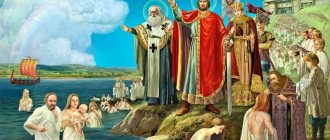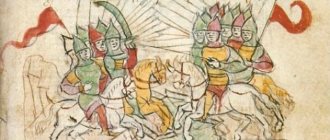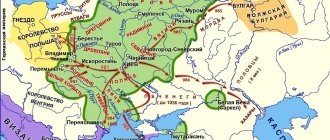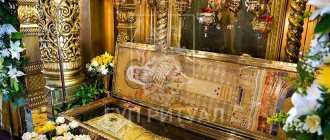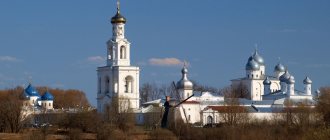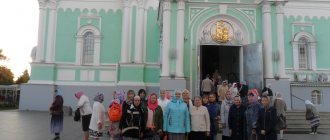The question of where Prince Vladimir was baptized remains controversial today. There are at least three versions of this. Supporters of the first name the place of baptism in Kyiv, the second - the town of Vasilyev, located not far from the first, and the third - Chersonesos. There is also no clear opinion about what year this event occurred. Today we propose to consider the opinion of a scientist, a supporter of one of the most popular versions regarding where Prince Vladimir was baptized.
Is the Baptism of Rus' a political move by Prince Vladimir?
Zlatnik of Prince Vladimir Svyatoslavich. 980–1015 State Hermitage
The Baptism of Russia is a conventional concept, behind which stands a whole series of decisions and events associated with different people and occurring at different times. Of course, the personal role of Prince Vladimir Svyatoslavich in the fact that the people of Rus' became Christian is great, but to reduce the whole matter to him alone from a historical point of view would be completely wrong. Vladimir is a kind of symbol of the adoption of Christianity by the Eastern Slavs. That is why he is revered as an Orthodox saint and is depicted in the images of historical memory (icons, paintings, monuments, and so on) of modern peoples who emerged from medieval Rus' - Ukrainians, Belarusians and Russians.
First of all, it is necessary to distinguish between the decision of the prince himself and some of his close relatives to accept baptism and the desire of the ruling elite of the Kyiv state to reject pagan cults and accept Christianity as the official and obligatory religion for the entire population. In addition, the introduction of an official and mandatory religion for everyone could not happen in one day and from scratch: an event of such a scale had many different prerequisites (and not only political, but economic and cultural).
When discussing the events of a thousand years ago, one must understand that very few sources from the reign of Vladimir have survived, and those that have survived are difficult to interpret unambiguously. In fact, only a few brief and fragmentary foreign messages have reached us, as well as some objects: for example, coins that began to be minted at the beginning of the 11th century at the court of the already baptized Vladimir, with his image as a Christian ruler (the prince is depicted with a cross and other attributes of the Christian faith , an image of Jesus was usually minted on the reverse side of the coin). Izvestia This is how chronicle messages are usually called in historiography. The Kyiv Chronicle and some other ancient Russian texts about the Baptism of Rus' were written down many decades after the death of the prince, and mostly these are just legends.
“The Tale of Bygone Years” “The Tale of Bygone Years” is an ancient Russian chronicle compiled in Kiev in the 1110s. Of several editions, two have reached us: as part of the Laurentian and Ipatiev Chronicles, which underlies the most common ideas about the events of that time, took a long time to develop. In the middle of the 11th - beginning of the 12th century, it was edited by several Kyiv scribes, so many contradictions can be found in the text. It is rather the fruit of historical and literary creativity, partially and distortedly telling about real events. It is not the “presumption of innocence”, but rather the “presumption of mistrust” that determines the attitude of modern historians towards him.
Bearing in mind all these circumstances, we must, firstly, admit that we cannot know the real motives of Prince Vladimir, who decided to be baptized, and secondly, that the decision to adopt Christianity as the state religion was a consequence of the interests of the elite of Kievan Rus and objective needs of this state.
Popular message topics
- Stone Age Travelers
Planet Earth is quite impressive in size, but in reality, people have explored the space of the planet since ancient times and were able to overcome gigantic distances. As Thor Heyerdahl proved earlier to people - River Nile
The Nile is one of the greatest rivers on earth. It is the most famous river in Africa. It plays an important role not only in transport, but also performs many functions of the African eco-system. There is still controversy surrounding this river, - The works of Ivan Bunin
The works of Bunin, of course, make up the majority of all world literature. His works are currently very popular not only in his homeland, but also abroad.
If so, then when was Vladimir himself and his loved ones baptized, and when was the rest of Rus'?
Council of Vladimir Svyatoslavich with the boyars and squad about the place and time of the adoption of Christianity by Russia. Miniature from the Radziwill Chronicle. Late 15th century Library of the Academy of Sciences in St. Petersburg
According to the Tale of Bygone Years, the baptism of Prince Vladimir and his “squad,” that is, the Kiev elite, took place in Chersonesos in 988. In the same year, but a little later, when Vladimir and his army returned to Kyiv, by order of the prince, the people of Kiev were to be baptized. According to the Novgorod Chronicle, soon, although it is not known exactly when, baptism took place in Novgorod.
The Tale of Bygone Years speaks about baptism in other cities and regions subject to Kyiv:
“And [the prince] began to install churches and priests throughout the city, and bring people to baptism throughout the city and village. And, having sent, he began to take children from the deliberate child and give them for book teaching. And the mothers of their children wept for them, and for fear they had not yet confirmed their faith, but as if they were weeping for a dead man.” “And in other cities [the prince] began to build churches and appoint priests in them and bring people to baptism in all the cities and villages . He sent to collect children from the best people and send them to book education. The mothers of these children wept for them, for they were not yet established in the faith, and wept for them as if they were dead.” The Tale of Bygone Years. St. Petersburg, 1996. .
But there is another ancient text that describes a different chronology of the baptism of Vladimir and Rus'. This is the so-called “Memory and Praise to the Russian Prince Vladimir” by Jacob Mnich (that is, the monk), probably written in the middle of the 11th century. Jacob writes that the baptism of Vladimir and the capture of Chersonesos were not directly related. The prince was baptized in Kyiv back in 987, and captured Chersonesus and married Anna of Byzantium not in 988, but in 989.
In fact, the chronicle does not explain the reasons for the capture of Chersonesos. And in the text of Jacob and some other sources it is written that Vladimir decided to take the city in order to obtain the extradition of Princess Anna from Byzantium - the imperial family, apparently, desperately did not want to become related to the wild barbarian that the Greeks imagined the prince to be. Modern scholars have serious reasons to believe Jacob rather than the Tale of Bygone Years.
We have no other data on the chronology of Baptism, but it is clear that the Christianization of the entire population over a vast territory from the Black Sea steppes to the Novgorod forests could not take place in one day or even one year. The above quotation from The Tale of Bygone Years implies this by noting that many “have not yet become established in the faith”—obviously, “establishment” must have taken a long time.
How did the gazebo come about?
Previously, through the baptismal chapel, which was not fenced, there was a path to the beach, and people came here. As you know, during the years of perestroika, the authorities’ attitude towards the church changed, and the revival of temples and churches began. The then dean of the local district, Father Georgy Polyakov, had the idea of installing a gazebo here in order to somehow immortalize the place where Prince Vladimir was baptized. When it was made and had to be installed, support was not found from the museum management. This was in the late 90s of the last century.
Then Father George found an original way out. The specialists with whom he agreed delivered the gazebo to the font by helicopter. It was lowered as accurately as possible, and then attached to the rock in the most reliable way. This is how the place where Prince Vladimir was baptized was marked.
Were there any other options besides Orthodoxy?
Grand Duke Vladimir chooses faith. Painting by Ivan Eggink. 1822 State Museum of the History of Religion, St. Petersburg
The answer to this question can be found in the ancient Kiev chronicle, which was included in the Tale of Bygone Years. Its author, a chronicler who most likely lived in the second half of the 11th century, compiled the so-called story “about the choice of faiths.” In the “Tale of Bygone Years” under the years 986–987, it first says that proselytizers came to the court of the Kiev prince Vladimir Svyatoslavich. Proselytism is an activity aimed at converting people of other faiths to their religion. embassies of Mohammedans, Jews, Catholics and Orthodox Christians, and then that the prince himself, after consulting with the “boyars and elders” - the elite of the then society - sent his ambassadors to the Volga Bulgarians, the “Germans”, that is, the Catholics. and the Greeks “to experience the service of how to serve God” Tale of Bygone Years. St. Petersburg, 1996. .
This legendary story was based on folklore and literary motifs. But its essence reflected reality: in Kievan Rus they knew about different religions that were common in neighboring countries. The story “about the choice of faiths” says that Jews from Khazaria, Muslims from Volga Bulgaria, as well as Christians from Rome and Constantinople came into contact with Kiev. Sources independent of the chronicle, although they do not confirm exchanges of embassies at this time, do indicate contacts with these peoples in the religious sphere in the 10th century. For example, Princess Olga, Vladimir’s grandmother, was actually baptized in Byzantium. However, later, according to German sources, she, dissatisfied with political relations with Byzantium, turned to the German king Otto I with a request to send a bishop and priests to Rus'. In 961, a German bishop even arrived in Kyiv, but his mission (he was supposed to convert Rus' to Catholicism) ultimately failed.
Prince Yaropolk Svyatoslavich, Vladimir’s elder brother and his predecessor on the Kiev “table,” that is, the throne, also had contacts with the German imperial court. Some historians, not unreasonably, believe that Yaropolk even managed to receive Catholic baptism before the war with Vladimir, in which he died.
On the other hand, no later than the middle of the 10th century, a Jewish community was formed in Kyiv. This is evidenced by the oldest document created in Kievan Rus - the so-called Kievan letter, a message in Hebrew on behalf of this community, preserved in the Cairo Geniza - the archive at the synagogue. It was about financial assistance to one of the community members. Unfortunately, this message does not have an exact dating, but scientists place it around the middle of the 10th century. Among the names of community members there are Slavic ones, and this directly confirms Jewish proselytism in the capital of Rus'.
There is no direct evidence of Islamic proselytism on the territory of Rus'. But in Rus' they knew exactly what Islam was: since the 9th century, it was united by close, primarily trade and economic, but also military contacts with Volga Bulgaria and the Arab Caliphate. We have a variety of evidence about these contacts (including from Arabic sources of the late 9th - early 10th centuries), and often in the form of detailed stories.
Theoretically, the elite of the Kyiv state could turn to different countries with a request for help in establishing a monotheistic religion. A Western alternative was also possible, that is, the adoption of Christianity from the Roman Curia through Germany.
But Orthodoxy, which came from Constantinople, had the greatest chances: back in the 9th century, Christianity began to spread from there to the north, mainly to the Slavic regions. Naturally, for Dnieper Rus', the path to breaking with paganism led to Byzantium, with which the ruling elite of Rus' had the closest trade and economic relations. Arab writers report that at the end of the 9th century, some merchants from Rus' who came to the Arab Caliphate said that they had been baptized.
Of great importance is the evidence of the treaty between Russia and the Greeks in 944, which was included in the “Tale of Bygone Years” in a copy with a translation into Church Slavonic. Some of those who concluded it from the Russian side were Christians and swore according to Christian rites, that is, they kissed the cross. And among the archaeological finds of the late 9th - early 10th centuries there are objects of Christian worship: crosses, candles and the like.
The Baptism of Rus' and the legacy of paganism
Why did Vladimir choose Christianity? Lecture from the course “History of Russian Culture”
How did Vladimir make the decision?
By the time of his marriage to Princess Anna, Vladimir was already ready for baptism. According to the chronicle, back in 986 he raised the question of which faith to choose. He received ambassadors from Volga Bulgaria who offered to convert to Islam, Khazar Jews who invited him to Judaism, and missionaries from the Vatican. But they were all refused. After them, a Byzantine arrived who spoke about the Christian faith.
To find out how rituals were carried out and what laws each religion had, the prince sent ambassadors to worship the Germans, Greeks and Muslims. Ultimately he chose Christianity.
What would have happened if Rus' had not been baptized? Would we remain pagans?
The reign of Vladimir Svyatoslavich in Kyiv; the erection, at his command, of wooden figures of the god Perun and other pagan deities on the hill. Miniature from the Radziwill Chronicle. Late 15th century Library of the Academy of Sciences in St. Petersburg
Probably, for some time paganism could exist in Russia as the main cult. In any case, it is known that in neighboring Poland, after the adoption of Christianity at the end of the 10th - beginning of the 11th century, a period of pagan reaction began (it was expressed in a series of uprisings against the ruling Piast dynasty in the 1030s), and in more distant Scandinavia Christianity remained for a long time ( until the end of the 12th century) gained ground. But paganism was doomed to disappear. There is an example of some West Slavic tribes (Polabian Slavs - Obodrits, Lutichs and others), who, in the face of German aggression in the 10th-12th centuries, acting under the slogans of baptism, “mothballed” their pagan beliefs. For some time, this conservation helped them defend their original culture and political independence, but by the end of the 12th century they lost their independence and became part of the German states. But those Slavs who adopted Christianity were just able to defend their independence.
Background to the adoption of Christianity in Kievan Rus
Before we begin to describe the procedure for the baptism of Rus' by Vladimir, we should understand the background, prerequisites and reasons for this process.
For Byzantium, conversion to Christianity in relations with warlike peoples who professed paganism was a common practice. In the 9th century there were attempts to Christianize Moravia (in 862) and Bulgaria (in 864-920). Through the baptism of the ruling circles, Byzantium tried to strengthen its influence on pagan countries, thereby reducing the danger of military action on its own borders.
After the Rus attacked Constantinople in 860, similar tactics were used against Kievan Rus. For this purpose, Photius I, Patriarch of Constantinople, sent missionaries to Kyiv. There is evidence that at that time the Kyiv princes Dir and Askold, along with the boyars, as well as some representatives of the people, converted.
This marked the beginning of the baptism of Rus'. Some sources, however, reject this information. But in a number of others, the mentioned events of the baptism of Rus' are called the first Photius baptism, or Askold’s.
But historical periods associated with the names of other persons are also named. For example, regarding what century the baptism of Rus' dates back to and what year, it is said that it occurred for the first time during the time of Vasily I, who ruled in 867-886, and Patriarch Ignatius, who headed the Church of Constantinople in 867-877.
Was Rus' forcibly baptized?
Baptism of Rus'. Sketch by Viktor Vasnetsov for the painting of St. Vladimir's Cathedral in Kyiv. 1890 State Tretyakov Gallery
The oldest sources do not report any violence: neither from other states, nor from the Kiev authorities. The literature still refers to reports of some resistance to baptism with armed confrontation (for example, in Novgorod), but this is unreliable information based on later speculation and legends.
Baptism of Rus': prayers
Troparion, tone 8
Blessed are you, Christ our God, / who enlightened the Russian land with Baptism, / sending down the Holy Spirit to its people, / leading them to salvation, // Lover of mankind, glory to you.
Kontakion, tone 3
Today the Russian land stands before God / and bears the fruit of holy Baptism to Him, / The angels, rejoicing, glorify, / and all the saints with the Mother of God, rejoicing, sing: / Christ reigns, Christ is glorified. / Great art thou, O Lord, and wonderful are thy works, // Our God, glory to Thee.
Prayer at a prayer service in memory of the 1000th anniversary of the Baptism of Rus'
Trinitarian God, Father Almighty, Only Begotten Son, Savior of the world, and Holy Soul, enlighten and sanctify tribes and peoples! Who also guided the ruler of the Russian land, Prince Vladimir, to the light of the true faith, and thus enlightened our entire country with Baptism, and granted to shine with a host of saints, like the bright stars that adorned the sky of the Russian Church! And to us, their humble and unworthy children, who are now standing before Your glory and bringing thanksgiving prayers on this thousand-year day of the Baptism of Rus', You have granted great mercy, to glorify, praise and bring thanks to You for all the good deeds that have been in Rus' from ancient years to the present day. . Look upon Thy field, the Holy Church, and upon our Fatherland, bringing to Thee, like the beautiful fruit of the saving sowing of Thy Word, the faces of the saints. You have served the people with your faith, hope and love, by the way of speech and life, showing us the path to perfection according to the commandment of Christ: be ye therefore perfect, even as your Heavenly Father is perfect. Preserving this holy heritage of theirs, we pray to Thee, the Giver of Life: save and have mercy on us, grant peace to Thy world and to all Thy creation, which, through our sin, the sons of this age will hold with the fear of death. We know that you do not want the death of sinners, but rather turn and let them be alive; look upon us who are in sin, turn away Thy anger that righteously moves against us, grant us repentance and have mercy on us with Thy ineffable mercy. Accept our prayers and labors for the increase of love among all the people of this world. Fence the Russian land, make the authorities wise, comfort and please everyone, grow Your Church, preserve Your heritage, enlighten men and women and babies with grace, and establish all Your people in Orthodoxy and piety with the prayers of Your Most Pure Mother, by the power of the Honest and Life-giving Cross and All saints who have shone in our land, so that in the unity of faith and love we glorify Thee, the Father and the Son.
Was there resistance and protests?
Prince Gleb Svyatoslavovich kills the sorcerer at the Novgorod Veche (Princely Court). Painting by Andrey Ryabushkin. 1898 Nizhny Tagil Museum of Fine Arts
We know nothing about resistance and protests in the era of Vladimir. Another thing is that the Christianization of the entire population of Rus' was a long process: the chronicle reports some unrest in individual cities and regions of Rus' later, in the 11th century. To varying degrees, the protesters used slogans of pagan reaction. For example, in Suzdal in 1024 there were unrest due to famine, and pagan Magi (priests) took an active part in them. Under the year 1071 (in reality, the events most likely took place in 1074), the Tale of Bygone Years describes the adventures of the Kyiv boyar Yan Vyshatich in the Upper Volga region. Famine reigned in Rus' at that time, and unrest against the authorities began. Jan had to suppress them and even conduct a theological dispute with the Magi, who were depicted as the leaders of the protest. In Novgorod in 1071, a revolt against the prince and bishop was also led by a certain sorcerer; unrest occurred during the evening, but the decisive actions of the prince and his squad stopped them.
Princess Olga and relations with Constantinople
Understanding what the baptism of Rus' is, it is necessary to say about the role that Princess Olga played in this process.
She was the first ruler in Kyiv to officially convert to Christianity. The most reasoned version gives the date - 957. Together with a large embassy and her son Svyatoslav, she visited the capital of Byzantium, which is known from the work “Ceremonies” written by Emperor Constantine Porphyrogenitus, where Olga is named archontissa, that is, the ruler of Rus'.
She made attempts to achieve the baptism of her state and its recognition by Byzantium as an equal to the Christian empire. After being baptized, she received her second name - Elena. In 959, she received the Greek embassy in Kyiv, but refused to send an army to help Byzantium. In the same year, Olga sent ambassadors to Otto I, the German emperor, with a request to send bishops and other priests to her in order to establish a church in Rus'.
The ruler’s attempt to play on the Byzantine-German contradictions was quite successful; Constantinople became more compliant, and a mutually beneficial agreement was concluded with it. And the German ambassadors returned home empty-handed. In 960, a Russian army was sent to help the Greeks. It took part in military operations under the leadership of Nikephoros Phocas, the future Byzantine emperor, on the island of Crete against the Arabs.
After that, did they immediately start building churches and painting icons?
The consecration of the Mother of God (Tithe) Church in Kyiv, built by order of Vladimir Svyatoslavich by Greek craftsmen and decorated with icons and utensils from Korsun, and the appointment of Anastas and other Korsun priests as ministers in it. Miniature from the Radziwill Chronicle. End of the 15th century Library of the Academy of Sciences in St. Petersburg
The chronicle reports that after mass baptism in Kiev, by order and at the expense of the prince, they began to “set up churches and priests throughout the city” The Tale of Bygone Years. St. Petersburg, 1996.. It specifically talks about the construction of the Tithe Church of the Virgin Mary in the city. It began to be called tithe because a tenth of the prince’s income was allocated to support it. The church was a very representative building; it was decorated with mosaics and frescoes. It was severely damaged during the capture of the city by the Mongols at the end of 1240, and then gradually collapsed until the 20th century. Archaeologists discovered its foundation (which can still be seen today) and confirmed that the church was built at the end of the 10th century. It is known that after the death of Vladimir in 1015, there were already hundreds of churches in the city: in addition to the Tithe Church, the then wooden St. Sophia Cathedral and other large churches, numerous small private churches and chapels were also built. Obviously, they must have had some kind of icons, but the oldest surviving icons of pre-Mongol Rus' date back to no earlier than the middle of the 11th century.
Opinion of Vasily Tatishchev
It is interesting that, according to the historian Vasily Tatishchev, who is based on information from the Joachim Chronicle, supposedly belonging to Joachim, the first Novgorod bishop who died in 1030, Yaropolk Svyatoslavovich, the Kiev prince who reigned from 972 to 978, also expressed sympathy for Christianity or 980.
As you know, he was killed by the Varangians on the orders of his brother Vladimir. It should be noted that this chronicle contains unique information on the early history of both the Slavs and Ancient Rus', but is controversial, since exact correspondence has not yet been found in other sources.
And everyone started wearing crosses?
The pendant cross is one-sided. Veliky Novgorod, late 11th century Institute of Archeology RAS
Yes, after baptism, many actually began to wear crosses. In the graves of the 11th century, burials in which were performed according to Christian rites, the dead, as a rule, lie with crosses. In chronicles and other texts of the late 11th - 12th centuries, the custom of wearing a pectoral cross is already mentioned as a matter of course and universal.
Archaeological data
It should be noted that although archaeological data confirm the century of the baptism of Rus', they still say that the spread of Christianity began earlier than the official date - 988. This is evidenced by the finds of Christian antiquities, which, in particular, include pendant crosses, that is, body crosses, candles and other objects.
They were mainly found in the burial complexes of warriors. They have been recorded since the middle - third quarter of the 10th century in the key points of the Old Russian state. These are cities and churchyards. The latter in this case refers to military centers and trade and craft settlements. For example, these:
- Kyiv.
- Gnezdov - not far from Smolensk.
- Shestovitsa – near Chernigov.
- Timerev - near Yaroslavl.
Byzantine coins with Christian images were found, as well as Central Asian (Samanid dirhams) with graffiti depicting a cross. Byzantine coins were also worn as icons, and crosses were cut out of dirhams. Graffiti in the form of crosses was also depicted on everyday objects.
For the middle - second half of the 10th century, a period that, according to archaeologists, is the initial stage of the Christianization of Rus', pendants in the form of a cross, which were made of sheet silver, are characteristic. They were discovered in Kyiv, Gnezdovo, Timerevo, in the Pskov necropolis, on the territory of Iskorosten - the administrative and political center of the Drevlyans.
It should be noted that on international routes the movement of money was controlled and distributed by the princely squad, where religion gradually became syncretic, that is, combining elements of several beliefs. It is this pre-Christian era that is considered the period of “dual faith”.
In some of the burials of the nobility, which were made in pagan necropolises of the 9th century, candles were found in special wooden compartments deepened into the ground there. And this indicates the use of Christian elements in funeral rites. This applies to Gnezdov, Timerev and Shestovitsa.
Where did the priests and other clergy come from?
Baptism of Princess Olga in Constantinople. Sketch by Ivan Akimov. 1792 State Russian Museum
The first clerics Cleric is the general name for clergy or clergy. began to appear in Kyiv and, probably, in other cities of Rus' long before 988. As we already wrote above, Princess Olga was baptized in Constantinople, and the Byzantine sources reporting this mention that she had a priest with her, who, apparently, stayed with her in Kyiv. According to the chronicle, Vladimir brought some clergy with him from Chersonesos. Some clergy probably arrived with the metropolitan, who came to Kyiv within a few years after the Epiphany. Later, the clergy were recruited from the local population. The chronicle speaks about this, albeit in the form of legends, in the news about the “book teaching” (meaning that “teaching” is necessary for worship) of the children of the “deliberate child”, that is, the children of the “best people”. The Tale of Bygone Years. St. Petersburg, 1996. .
Baptism of other Russian lands
In Kyiv, Christianization took place relatively peacefully, because the townspeople respected their ruler and revered his decrees. There is no evidence that any pagans contradicted the prince or tried to refuse to step on the path of the true faith. The situation was completely different in other Russian principalities.
Rus' was divided territorially. The southern and western cities did not defy the will of the Grand Duke. Here, as in Kyiv, local princes were able to organize centralized sacraments of baptism. Thus, they recognized not only the Orthodox faith, but also the authority of Vladimir as a single sovereign.
But in the north and east, anti-Christian sentiments were strong. However, it would be more appropriate to call them anti-Kievan, because many princes opposed the unification of Rus' under one ruler, because they wanted to preserve their sovereignty. In the Novgorod principality, the resistance of the masses turned into popular uprisings. The Novgorodians were not going to give up paganism and condemned the destruction of places of worship. Such active confrontation forced the people of Kiev, led by Dobrynya, who was the Grand Duke’s uncle, to forcefully spread Christianity.
The houses of many soldiers who stood on the side of paganism were burned during the siege of Novgorod. Only then, in 991, did the city residents decide to go to war. They allowed the people of Kiev to preach in the name of the Greek faith, and also to build their churches, but they themselves refused to recognize their righteousness. Then, as in Kyiv, Dobrynya had to destroy the pagan temples and throw the wooden idol of Perun into the river. Thus, the Novgorodians, who considered Vladimir a traitor to the faith of their ancestors, surrendered.
Although the tenth century marked the beginning of Kyiv Christianization, the Orthodox faith reached certain territories much later. Thus, those lands that were inhabited by Finno-Ugric tribes abandoned paganism many years later. It is believed that Rostov was baptized in 1078. And the residents of Murom completely refused to allow Gleb Vladimirovich, the son of the Grand Duke, into the walls of the city. It took the Kyiv rulers 200 years to conquer the Murom people and force them to turn to the path of the true faith.
It is known that the Baptism of Rus' was one of the factors in the settlement of the Slavs in the northeastern territories. The pagans, who did not want to submit to the newly-minted Church, fled from their cities to the territory between the Volga and Oka. This resettlement, called Slavic colonization, continued until the middle of the thirteenth century. Nizhny Novgorod was founded in 1221, and even then Orthodoxy was not widespread throughout Russian soil.
Vladimir Krasno Solnyshko
Officially, the date of adoption of Christianity in Rus' is July 28, 988. Today is a memorable day, which was established by federal law on June 1, 2010. This date in the Orthodox church calendar (according to the old style it falls on July 15) is the day of memory of Prince Vladimir, whose years of life are 960-1015.
He is called the Equal-to-the-Apostles Baptist of Rus' by the church, by historians as great, and by the people as Krasno Solnyshko. In 2008, the Council of Bishops of the Russian Orthodox Church decided to hold a divine service on July 28 in accordance with the charter of the great holiday.
Prince Vladimir was the son of Prince Svyatoslav and Malusha, the “virgin of things”, who converted to Christianity in Constantinople along with Vladimir’s grandmother, Princess Olga.
His independent reign began at the age of 17. As legend says, at that time the young prince was a pagan; he loved military campaigns and noisy feasts. However, it was he who was destined to become the baptist of Rus'.
There is no such beauty on earth
The ruler began to consult with his entourage, and it was decided to test his faith further. A year later, in 987, the prince himself decided to send messengers to different lands to find out how other peoples served God. Having returned, the messengers said that they were most impressed by the service in Constantinople, that is, in Constantinople.
She simply delighted them. The envoys reported that during the church ceremony they did not know where they were - on earth or in heaven, since they had not seen a spectacle of such beauty on earth. According to the chronicle, after thinking, Vladimir decided to be baptized according to the rules of the Greek rite, and was supported by his neighboring boyars. However, the baptism of Rus' by Vladimir was preceded by a number of events.
